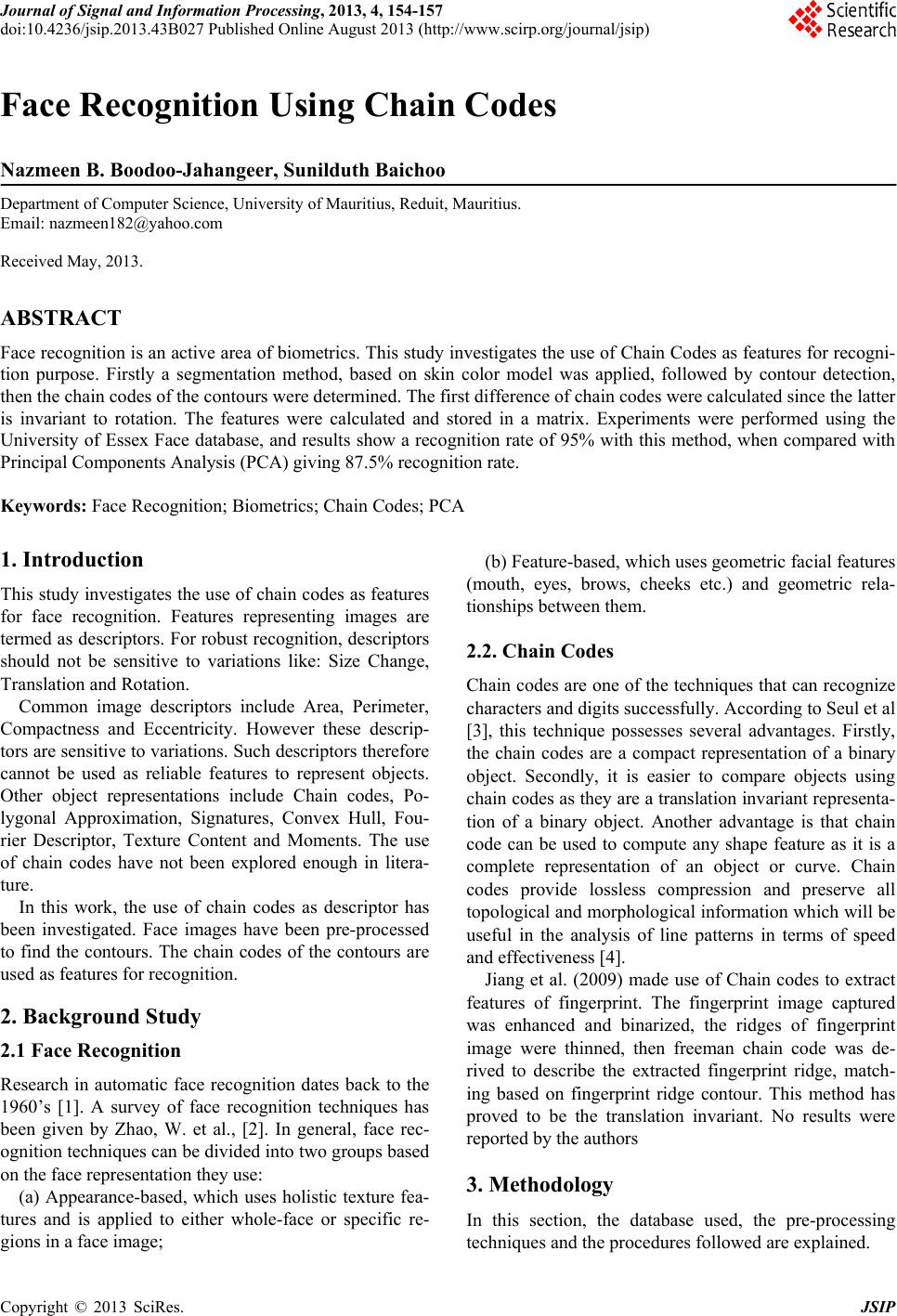
Journal of Signal and Information Processing, 2013, 4, 154-157
doi:10.4236/jsip.2013.43B027 Published Online August 2013 (http://www.scirp.org/journal/jsip)
Face Recognition Using Chain Codes
Nazmeen B. Boodoo-Jahangeer, Sunilduth Baichoo
Department of Computer Science, University of Mauritius, Reduit, Mauritius.
Email: nazmeen182@yahoo.com
Received May, 2013.
ABSTRACT
Face recognition is an active area of biometrics. This study investigates the use of Chain Codes as features for recogni-
tion purpose. Firstly a segmentation method, based on skin color model was applied, followed by contour detection,
then the chain codes of the contours were determined. The first difference of chain codes were calculated since the latter
is invariant to rotation. The features were calculated and stored in a matrix. Experiments were performed using the
University of Essex Face database, and results show a recognition rate of 95% with this method, when compared with
Principal Components Analysis (PCA) giving 87.5% recognition rate.
Keywords: Face Recognition; Biometrics; Chain Codes; PCA
1. Introduction
This study investigates the use of chain codes as features
for face recognition. Features representing images are
termed as descriptors. For robust recognition, descriptors
should not be sensitive to variations like: Size Change,
Translation and Rotation.
Common image descriptors include Area, Perimeter,
Compactness and Eccentricity. However these descrip-
tors are sensitive to variations. Such descriptors therefore
cannot be used as reliable features to represent objects.
Other object representations include Chain codes, Po-
lygonal Approximation, Signatures, Convex Hull, Fou-
rier Descriptor, Texture Content and Moments. The use
of chain codes have not been explored enough in litera-
ture.
In this work, the use of chain codes as descriptor has
been investigated. Face images have been pre-processed
to find the contours. The chain codes of the contours are
used as features for recognition.
2. Background Study
2.1 Face Recognition
Research in automatic face recognition dates back to the
1960’s [1]. A survey of face recognition techniques has
been given by Zhao, W. et al., [2]. In general, face rec-
ognition techniques can be divided into two groups based
on the face representation they use:
(a) Appearance-based, which uses holistic texture fea-
tures and is applied to either whole-face or specific re-
gions in a face image;
(b) Feature-based, which uses geometric facial features
(mouth, eyes, brows, cheeks etc.) and geometric rela-
tionships between them.
2.2. Chain Codes
Chain codes are one of the techniques that can recognize
characters and digits successfully. According to Seul et al
[3], this technique possesses several advantages. Firstly,
the chain codes are a compact representation of a binary
object. Secondly, it is easier to compare objects using
chain codes as they are a translation invariant representa-
tion of a binary object. Another advantage is that chain
code can be used to compute any shape feature as it is a
complete representation of an object or curve. Chain
codes provide lossless compression and preserve all
topological and morphological information which will be
useful in the analysis of line patterns in terms of speed
and effectiveness [4].
Jiang et al. (2009) made use of Chain codes to extract
features of fingerprint. The fingerprint image captured
was enhanced and binarized, the ridges of fingerprint
image were thinned, then freeman chain code was de-
rived to describe the extracted fingerprint ridge, match-
ing based on fingerprint ridge contour. This method has
proved to be the translation invariant. No results were
reported by the authors
3. Methodology
In this section, the database used, the pre-processing
techniques and the procedures followed are explained.
Copyright © 2013 SciRes. JSIP